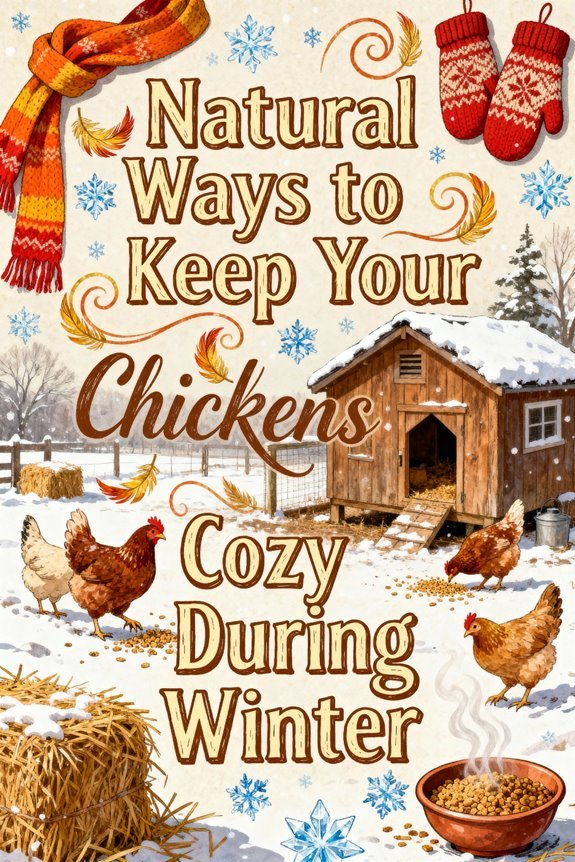Natural Ways to Keep Your Chickens Cozy During Winter
You’ll keep your chickens naturally cozy in winter by layering their coop with straw, wood shavings, or wool insulation to maintain warmth. Create draft-free zones by sealing gaps while ensuring proper ventilation near the roofline. Install wooden roosts 12 inches above the floor, allowing 9-12 inches per bird, and maintain deep bedding of 8-18 inches. Position windbreaks using evergreen boughs outside the coop. Our extensive guide offers more natural strategies for winter chicken care.
Understanding Natural Insulation Options for Your Coop
When winter approaches, choosing the right natural insulation for your chicken coop becomes essential for maintaining a comfortable environment. Straw insulation offers excellent temperature control through its dense fibers, while also repelling vermin and absorbing excess moisture. You’ll find it’s both renewable and biodegradable, making it an eco-friendly choice for your coop. Wood shavings provide exceptional moisture absorption and help control ammonia levels in the coop environment. Proper insulation becomes especially important for laying hens that need calcium absorption for strong eggshells during cold months. Adding fresh sage leaves to nesting areas can provide natural antimicrobial benefits while keeping the coop environment healthy.
Consider incorporating wool benefits into your insulation strategy. The natural lanolin in sheep’s wool provides superior moisture resistance while maintaining consistent temperatures. You can install it within wall cavities to prevent condensation and buffer against temperature swings. For enhanced results, combine these materials strategically – use straw bales for walls and floors, secured with twine to prevent gaps, while placing wool insulation in ceiling spaces where moisture typically accumulates.
Crafting a Draft-Free Environment the Natural Way
Creating a draft-free environment requires a systematic approach to identify and eliminate unwanted air currents while maintaining essential ventilation. Start by inspecting your coop for gaps around doors, windows, and wall joints, then apply natural draft sealing techniques using caulk or expanding foam. You’ll want to position ventilation holes high above roosting areas to prevent direct drafts on your chickens. Consider offering scratch corn treats in winter months to help chickens generate more body heat naturally.
Install natural barriers by layering straw, wood shavings, or dry leaves on the coop floor, and implement the deep litter method to generate gentle heat. Don’t forget to place windbreaks like evergreen boughs outside the coop where prevailing winds hit. Keep the environment dry by regularly replacing damp bedding and using carbon-rich materials to absorb moisture. Regular inspection of bedding areas can help detect lice infestations early, which are more common during fall and winter months. Remember to maintain small, adjustable vents for proper air exchange without compromising warmth.
Essential Ventilation Tips for Winter Comfort
While draft prevention keeps chickens protected from direct cold air, proper ventilation remains the cornerstone of winter coop comfort. You’ll want to position ventilation openings near the roofline, well above your chickens’ roosting areas, to let warm, moist air escape naturally. For ideal ventilation placement, install narrow slots at the tops of all four walls, ensuring they’re sheltered by roof overhangs to prevent rain and snow intrusion. This strategic placement helps reduce respiratory health risks from ammonia buildup.
Maintain about one square foot of ventilation per 10 square feet of floor space, using adjustable vents you can partially close during extreme weather. Focus on draft management by sealing unwanted cracks while preserving designed openings. Cover vents with predator-proof wire mesh and inspect regularly to prevent blockages from dust and debris.
Deep Bedding Strategies for Maximum Warmth
To establish a deep litter system that maximizes winter warmth, you’ll need to start with a 3-4 inch base layer of absorbent materials like pine shavings or industrial hemp. Add fresh bedding incrementally as needed, maintaining a depth between 8-18 inches for ideal composting benefits.
Encourage your chickens to help with the composting process by scattering scratch grains across the bedding. They’ll naturally turn and aerate the material while foraging. Consider adding crushed plantain leaves to the bedding material for additional immune support against common diseases. You should also rake the bedding periodically to prevent compaction and promote microbial activity. Proper ventilation helps maintain optimal moisture levels and prevents respiratory issues in your flock. Regular cleaning and maintenance of your deep litter system ensures your hens have comfortable nesting areas that support consistent egg production.
The composting benefits of deep litter include natural heat generation and improved coop insulation during cold months. This reduces your need for artificial heat sources. Plus, the beneficial microbes help break down droppings and suppress harmful bacteria, creating a healthier environment for your flock.
Smart Roosting Setup for Cold Weather
Since winter survival depends heavily on proper roosting conditions, setting up the right roost system is vital for your chickens’ comfort and health. Install wooden roosts made from 2×4 or 2×2 boards, as these won’t conduct cold like metal or plastic. Position them at least 12 inches above the floor and away from drafts, with smooth edges to prevent foot injuries. A properly sized coop providing 4 square feet per bird helps ensure adequate roosting space for the flock.
Your roost spacing should allow 9-12 inches per bird to let them fluff their feathers and share warmth naturally. Place roosts so chickens can face walls for protection, and consider installing multiple levels while maintaining safe heights. Keep the area beneath roosts clean and dry, using fresh bedding to prevent moisture buildup. Regular maintenance with non-toxic cleaners will help control parasites and guarantee your birds stay healthy through winter. Ensure that any gaps in the coop walls are sealed to eliminate harmful winter drafts that could compromise your chickens’ warmth.
Harnessing Nature’s Elements as Weather Barriers
Because winter winds can chill your chickens to dangerous levels, creating effective weather barriers becomes essential for their protection. You’ll want to combine both natural foliage and practical windbreak materials for the best results. Start by planting dense shrubs or installing wooden fences on your coop’s north and west sides to create natural windbreaks that trap snow away from entrances. A proper ventilation system helps prevent respiratory infections while maintaining warmth throughout the structure.
For immediate protection, repurpose durable feed bags or install translucent construction plastic to create a greenhouse effect while maintaining proper ventilation. Consider adding fine mesh screens with quarter-inch openings to disrupt wind flow without sacrificing air quality. For a long-term solution, mount UV-resistant polycarbonate panels on the lower half of your coop and run – they’ll let in natural light while keeping your flock warm and dry. These storm panel protection sets have proven highly effective with a 94% customer recommendation rate.
Monitoring Your Flock’s Winter Well-Being
Physical observation of your chickens becomes your primary defense against winter health issues once you’ve established proper weather barriers. Watch for early warning signs of cold stress: shivering chickens need immediate attention, while lethargy and excessive huddling indicate depleted energy reserves. Proper monthly health checks can help prevent escalation from minor to severe health issues. Monitor your flock behavior daily, paying close attention to their winter feeding patterns and water consumption. Hardy chicken breeds like Rhode Island Reds adapt better to extreme winter conditions. Watch closely for signs of pecking behavior that can increase due to winter confinement stress.
Check combs and wattles regularly – they should maintain a bright red color. Look under feathers for mites or lice, which can flourish in winter months. You’ll need to examine their keel bones for adequate fat padding and inspect for respiratory symptoms that cold weather can aggravate. Keep a thermometer in the coop to guarantee temperatures stay above 35°F, and adjust ventilation to prevent dampness without creating drafts.





